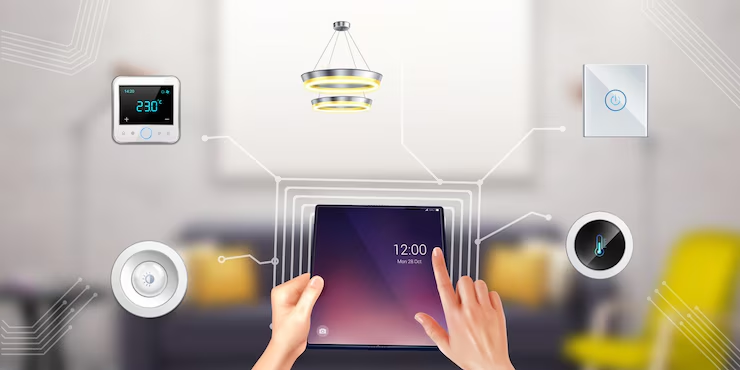Smart home security is no longer a luxury—it’s an essential shield for modern households. The global smart home market is projected to reach US$174.0 billion in 2025, with the security segment alone valued at about US$32.5 billion, growing at a 9.55% CAGR between 2025 and 2029 StatistaStatista. In the United States, nearly 69.91 million households are actively using smart home devices in 2024—a 10.2% increase year-over-year—and over 60% of consumers are expected to adopt smart home security by 2025 OberloExploding Topics. From video doorbells to AI-powered hubs, these advanced gadgets not only deter burglars but also offer peace of mind through real‑time alerts, remote access, and seamless integration. In this post, we’ll explore why you need smart home security, unveil seven must‑have devices, answer your burning FAQs, and share pro blogging strategies to amplify your content’s impact—all wrapped in a casual, engaging tone that keeps you hooked until the end.
Introduction
Imagine this: it’s late at night, and you’re cozied up on your couch when your phone buzzes. A motion-activated smart camera has detected movement on your front porch. You tap your app, see a delivery driver placing a package, and unlock your smart lock—all without leaving your seat. That’s the power of smart home security devices in action. They blend cutting‑edge technology with real-life convenience, empowering homeowners to protect loved ones and valuables with just a few taps. Whether you’re a tech enthusiast or new to the smart home scene, now is the time to level up your security setup. Let’s dive in!
Table of Contents
- Why Choose Smart Home Security Devices?
- Top 7 Smart Home Security Devices to Invest in Now
- 2.1 Video Doorbells
- 2.2 Indoor & Outdoor Security Cameras
- 2.3 Smart Locks
- 2.4 Motion Sensors & Alarm Systems
- 2.5 Smart Lighting Automation
- 2.6 Smart Home Hubs & Integration
- 2.7 No‑Subscription Monitoring Options
- Frequently Asked Questions about Smart Home Security Devices
- Conclusion
- Notes
- Strategies to Consider
Why Choose Smart Home Security Devices?
Smart home security is more than just a trend—it’s a strategic investment in safety and convenience. According to Fortune Business Insights, the smart home safety and security segment grew 151% from 2019 to 2023, underscoring rapid consumer adoption Today’s Homeowner. Home security equipment costs an average of US$400, but basic systems can be assembled for as little as US$30—small compared to the US$2,000 average loss per burglary Today’s Homeowner. Beyond cost savings, smart devices offer real‑time alerts, remote monitoring, and integration with other home automation systems, creating a holistic defense network. In fact, 45% of US internet households own at least one smart home device, and 18% have six or more, highlighting growing trust and satisfaction among users SDM Magazine.

Top 7 Smart Home Security Devices to Invest in Now
2.1 Video Doorbells
Video doorbells let you see, hear, and speak to anyone at your door—from anywhere. Brands like Ring offer live HD video, two‑way audio, and motion detection. Basic plans start at US$4.99 per month for one camera, or US$49.99 per year, including 180 days of video history Ring. Pro tip: look for devices with AI person detection to reduce false alerts.
2.2 Indoor & Outdoor Security Cameras
High‑definition cameras are the backbone of any security setup. Arlo’s home security system, praised for its ease of setup, ranges from US$7.99 to US$24.99 per month for enhanced monitoring features ARLO. The Blink Mini 2 offers 1080p streaming for budget‑conscious buyers, though key features like person detection require a subscription starting at US$3 per month WIRED.
2.3 Smart Locks
Ditch keys and embrace PIN codes or smartphone unlocks. Yale Assure Lock 2, now integrated with ADT Plus and Google Nest, provides timed access codes for guests or service providers The Verge. Many locks support Z-Wave and Bluetooth, ensuring compatibility with popular hubs.
2.4 Motion Sensors & Alarm Systems
Standalone sensors can alert you to abnormal activity in seconds. SimpliSafe’s DIY alarm system costs about US$269 for a basic kit, with monitoring fees around US$20 per month—no long‑term contracts required Security.orgPCMAG. Pair motion sensors with door/window sensors for 360° coverage.
2.5 Smart Lighting Automation
Automated lights deter intruders by mimicking occupancy. Systems like Philips Hue integrate with security cameras and sensors to trigger lights upon detected motion or at scheduled intervals. Smart bulbs average US$15–US$50 each, and when combined with routines, can reduce energy bills by up to 27% IoT Now.
2.6 Smart Home Hubs & Integration
Unify your devices with hubs like Samsung SmartThings or Amazon Echo Show. These platforms support hundreds of protocols—Wi‑Fi, Z-Wave, Zigbee—and enable single‑app control. Hubs cost between US$80 and US$200, but unlock powerful automation and voice control.
2.7 No‑Subscription Monitoring Options
For those wary of ongoing fees, consider no‑subscription systems like SimpliSafe or local recording solutions (e.g., NAS storage). These options often require a higher upfront investment but eliminate monthly costs while retaining full functionality Security.org.

Frequently Asked Questions about Smart Home Security Devices
Q1: Are smart home security devices worth the investment?
Absolutely. With systems costing as little as US$30 and potential loss prevention of over US$2,000 per incident, ROI is clear—plus, remote monitoring adds unparalleled convenience Today’s Homeowner.
Q2: Do I need a monthly subscription?
Not always. While subscriptions unlock advanced features like cloud storage and AI detection, many brands offer basic functionality without fees. SimpliSafe and certain Arlo plans allow self‑monitoring with no contract Security.orgARLO.
Q3: Can smart devices be hacked?
Security concerns are real: 112 million cyberattacks targeted IoT devices in 2022, and 62% of owners fear unauthorized access IOT InsiderNationwide Marketing Group. To mitigate risks, choose devices with the U.S. Cyber Trust Mark, change default passwords, enable two‑factor authentication, and keep firmware updated AP News.
Q4: How do devices perform during power outages?
Most battery‑backed devices function seamlessly for hours. For hubs and cameras, consider adding battery or UPS backups. Some systems also offer cellular failover to maintain connectivity.
Q5: Are smart security devices difficult to install?
Not at all. Many plug‑and‑play systems require little more than mounting and Wi‑Fi setup. Users report sub‑15‑minute installations for video doorbells and sensors Lifewire.
Conclusion
Smart home security devices have revolutionized the way we protect our homes, blending advanced technology with everyday convenience. From video doorbells that greet your guests to motion sensors that guard every corner, these gadgets provide a robust, customizable defense against potential threats. With market growth accelerating and new cybersecurity labeling initiatives on the horizon, there’s never been a better time to upgrade your security setup. Embrace these seven devices, leverage pro tips, and rest easy knowing your home is safeguarded—today and beyond.
Notes
- Meta description:
Discover the top 7 smart home security devices transforming home protection in 2025. From video doorbells to AI‑powered cameras, learn how to deter burglars, monitor remotely, and integrate seamlessly—all while saving money and boosting peace of mind. - 10 tags:
smart home security, video doorbell, security camera, smart lock, motion sensor, home automation, DIY security, no‑subscription, smart lighting, cyber safety - 5 longtail tags:
best smart home security devices 2025, affordable DIY home security systems, how to secure smart home devices, smart home monitoring without subscription, U.S. Cyber Trust Mark devices
Strategies to Consider
- Compelling Headlines & Subheadings: Use numbers, power words, and emotional triggers to grab attention (e.g., “7 Unbeatable Devices”).
- Rich Media Integration: Embed high‑quality images, comparison tables, and demo videos to boost engagement and dwell time.
- Internal & External Linking: Link to authoritative sources (e.g., Statista) and related blog posts to improve SEO and user experience.
- Optimize for Featured Snippets: Structure FAQs with concise answers and include bullet lists to target “position zero” on Google.
- Clear Calls to Action: Encourage readers to subscribe, leave comments, or download a free security checklist to foster community and conversions.



